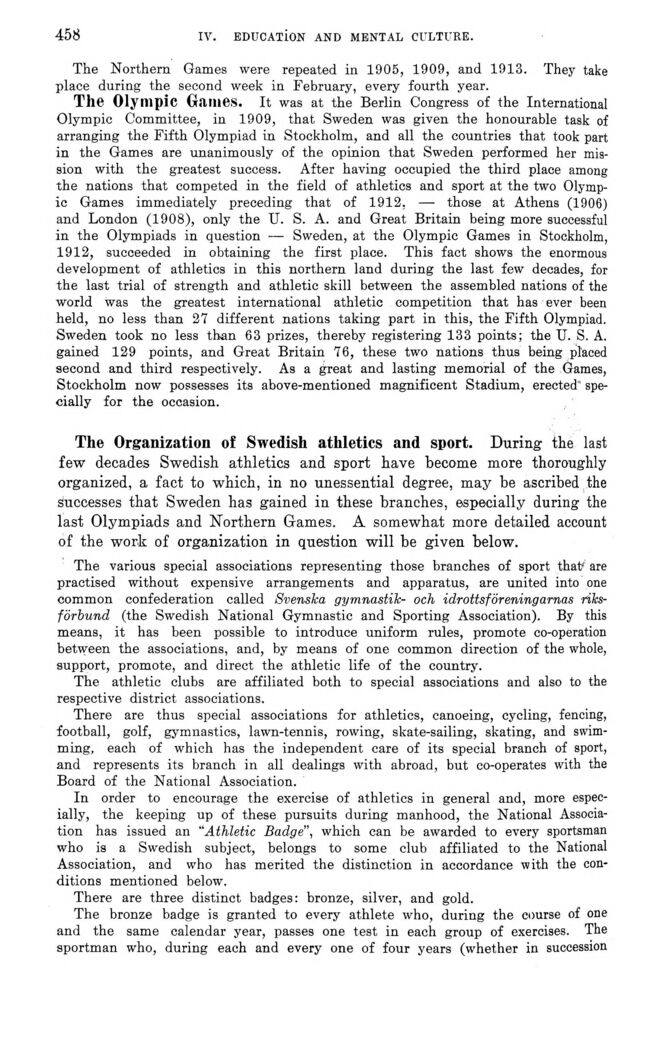
Full resolution (JPEG) - On this page / på denna sida - IV. Education and Mental Culture. Introd. by P. E. Lindström - 7. Athletics and Sport (Idrott). By [V. G. Balck] G. Åsbrink

<< prev. page << föreg. sida << >> nästa sida >> next page >>
Below is the raw OCR text
from the above scanned image.
Do you see an error? Proofread the page now!
Här nedan syns maskintolkade texten från faksimilbilden ovan.
Ser du något fel? Korrekturläs sidan nu!
This page has never been proofread. / Denna sida har aldrig korrekturlästs.
458
iv. education and mental cultulle.
The Northern Games were repeated in 1905, 1909, and 1913. They take
place during the second week in February, every fourth year.
The Olympic Games. It was at the Berlin Congress of the International
Olympic Committee, in 1909, that Sweden was given the honourable task of
arranging the Fifth Olympiad in Stockholm, and all the countries that took part
in the Games are unanimously of the opinion that Sweden performed her
mission with the greatest success. After having occupied the third place among
the nations that competed in the field of athletics and sport at the two
Olympic Games immediately preceding that of 1912, — those at Athens (1906)
and London (1908), only the U. S. A. and Great Britain being more successful
in the Olympiads in question — Sweden, at the Olympic Games in Stockholm,
1912, succeeded in obtaining the first place. This fact shows the enormous
development of athletics in this northern land during the last few decades, for
the last trial of strength and athletic skill between the assembled nations of the
world was the greatest international athletic competition that has ever been
held, no less than 27 different nations taking part in this, the Fifth Olympiad.
Sweden took no less than 63 prizes, thereby registering 133 points; the U. S. A.
gained 129 points, and Great Britain 76, these two nations thus being placed
second and third respectively. As a great and lasting memorial of the Games,
Stockholm now possesses its above-mentioned magnificent Stadium, erected
specially for the occasion.
The Organization of Swedish athletics and sport. During the last
few decades Swedish athletics and sport have become more thoroughly
organized, a fact to which, in no unessential degree, may be ascribed the
successes that Sweden has gained in these branches, especially during the
last Olympiads and Northern Games. A somewhat more detailed account
of the work of organization in question will be given below.
The various special associations representing those branches of sport that’ are
practised without expensive arrangements and apparatus, are united into one
common confederation called Svenska gymnastik- och idrottsföreningarnas
riksförbund (the Swedish National Gymnastic and Sporting Association). By this
means, it has been possible to introduce uniform rules, promote co-operation
between the associations, and, by means of one common direction of the whole,
support, promote, and direct the athletic life of the country.
The athletic clubs are affiliated both to special associations and also to the
respective district associations.
There are thus special associations for athletics, canoeing, cycling, fencing,
football, golf, gymnastics, lawn-tennis, rowing, skate-sailing, skating, and
swimming, each of which has the independent care of its special branch of sport,
and represents its branch in all dealings with abroad, but co-operates with the
Board of the National Association.
In order to encourage the exercise of athletics in general and, more
especially, the keeping up of these pursuits during manhood, the National
Association has issued an "Athletic Badge", which can be awarded to every sportsman
who is a Swedish subject, belongs to some club affiliated to the National
Association, and who has merited the distinction in accordance with the
conditions mentioned below.
There are three distinct badges: bronze, silver, and gold.
The bronze badge is granted to every athlete who, during the course of one
and the same calendar year, passes one test in each group of exercises. The
sportman who, during each and every one of four years (whether in succession
<< prev. page << föreg. sida << >> nästa sida >> next page >>